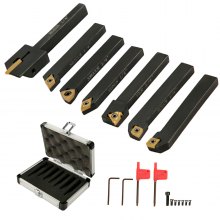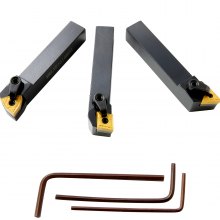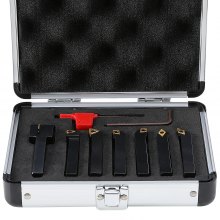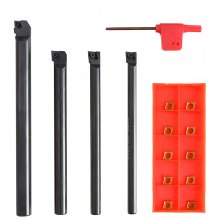Precision in Motion: VEVOR's Lathe Cutting Tools for Every Application
Tools used to produce turned pieces installed on a lathe are known as lathe-cutting tools. The workpiece's final shape is determined by its path along the lathe's axis.
VEVOR's lathe-cutting tools are the pinnacle of accuracy in action, with a dedication to quality ingrained in their very being. They provide a harmonious blend of dependability, adaptability, and performance for any application.
Components of a Lathe Cutting Tool
All lathe machine tools contain specific components, although their designs differ based on their applications and conditions. Below is a list of the common parts for every lathe cutting tool.
Shank
The lathe is coupled to this component. It is the instrument's thickest component and has a mostly rectangular cross-section.
Flank
This part engages in competition and interaction with the workpiece. This feature could be essential; the cutting instrument's side makes up the cutting edge.
Face
When the lathe is in operation, the chip moves onto this portion of the cutting tool.
Tool Nose
This is the intersection of the main and minor cutting edges. Its curve makes it stronger, more resilient, and smoother.
Cutting Edge
This part carries out the tool's cutting motion. The cutting edge is determined by the tool. A single-point tool, for example, has two cutting blades, which can cut on both surfaces.
Side Rake Angle
This consists of a line perpendicular to the body and the tool face. It establishes the chip flow's direction.
Back Rake Angle
It is the arc that the face and an angle opposed to the base form together. At a high rake angle, strength decreases, sharpness increases, and vice versa.
Side Cutting Edge Angle
This is the angle at which the side cutting edge produces a line opposite the tool's body. As such, it greatly affects the chip thickness and cutting force during the lathing processes.
End Cutting Edge Angle
The end cutting edge and a line perpendicular to the device's body and tangent to its nose combine to generate this angle. It prevents the tool from coming into touch with the workpiece's machining.
Lathe Cutting Tools Based on Operations
The machining process is another factor used to identify lathe cutting tools. The standard tools required in each lathe operation are examined below.
Materials can be removed along a workpiece's length using turning tools. It consequently causes the workpiece's diameter to decrease.
Much material can be removed from an item of work in a single pass using rough turning tools. As a result, they are frequently employed to produce rough patterns or to get surfaces ready for further finishing processes.
A tiny bit of metal is removed with the finish turning tool. An exact and smooth surface can be produced by a tool angle that is so finely tuned.
Chamfering Tool
When the cutting blades of straight-turning tools are angled to create a chamfer, they can also be used as chamfering tools. When performing several chamfer operations, a specialized chamfering tool with a side cutting edge angle matched to the chamfer's angle is utilized.
Thread Cutting Tools
Spiral thread designs can be created on cylindrical parts using thread-cutting equipment. Their nose angle typically varies based on the intended thread angle. Moreover, the tool's cross-section will impact the thread's pitch.
Forming Tools
Combining a turning and grooving tool into one, a forming tool helps create intricate designs quickly. A forming tool is the best option since it decreases cycle time and improves precision, even though a turning tool can accomplish the same task.
Grooving Tools
These instruments are used to create grooves on cylindrical workpieces. The shape of the lathe's machine tool determines the various types of grooves. Square and V-shaped cutting tools are common ones.
Boring Tools
A boring bar featuring a cutting tool at the end distinguishes a boring tool from a cutting tool. Thus, it can increase a hole's diameter while operating.
Knurling tools
Multiple metal rolling wheels with embossed patterns are a feature of knurling tools. They typically strengthen a workpiece's grip strength by creating indentations.
How to Choose the Right Lathe Cutting Tool
As everyone knows, the ideal task requires the appropriate equipment. Choosing the proper lathe cutting tools is crucial for achieving precise results on a piece of steel. Here's a list of tips for selecting the ideal lathe cutting tool.
Lathe Tools Coating
Coatings are compounds applied to a cutting tool's exterior to improve its mechanical and visual qualities. They are also crucial since coated lathe cutting tools have a longer lifespan than uncoated ones.
Required Part Shape
When choosing a lathe cutting tool, consider the tool and component shape as well. For instance, a rectangular facing tool can be used to form a cube shape on a material during facing operations.
Workpiece Material
The workpiece's mechanical characteristics will greatly influence the appropriate lathe cutting tool selection. Hardness is the primary criterion for selection since only uncoated or hard-coated tools should be used to turn hard materials.
Desired Turning Operation Types
A particular set of abilities and equipment are needed for each lathing procedure. Consequently, you must ensure that your selected instrument is appropriate.
They are not, however, the appropriate ones for forming activities. The direction of cutting is another factor to consider.
Why Choose VEVOR Lathe Cutting Tools
Regarding fine engineering and flawless craftsmanship, VEVOR is a leading company in the lathe cutting tool market. Not only does VEVOR prioritize quality, but it also always strives for excellence in all facets of its operations.
With its sturdy construction and cutting-edge innovations, VEVOR tools guarantee unmatched precision and effectiveness in turning procedures.
Every instrument is painstakingly designed to satisfy the various demands of both enthusiasts and experts, providing consistency and dependability with each cut.
FAQs About Lathe Cutting Tool
What materials can VEVOR lathe cutting tools work with?
VEVOR lathe cutting tools are made to deal with various materials, including composites, wood, plastic, and metals like brass, aluminum, and steel.
How do I properly maintain lathe cutting tools?
Proper maintenance is essential for lathe cutting tools to operate at their best and last longer. This includes routine wear and damage inspections, replacing or properly sharpening tools as needed, and utilizing lubricants or cutting fluids to lower heat and friction during machining.
Can lathe cutting tools be resharpened?
Most lathe cutting tools can be sharpened again to preserve their cutting edges and increase their usable life. However, several variables, including the tool's material, the degree of wear, and the operator's competence, affect how much a tool can be sharpened again.

























































































